|
| |
|
Collecting Nautical Antiques
by Bob Brooke
Before you start collecting nautical
antiques, you should visit maritime museums, purchase some good
reference books on the subject, and when it comes time to buy, find a
nautical dealer who will share his or her knowledge so that you can make
a profitable purchase.
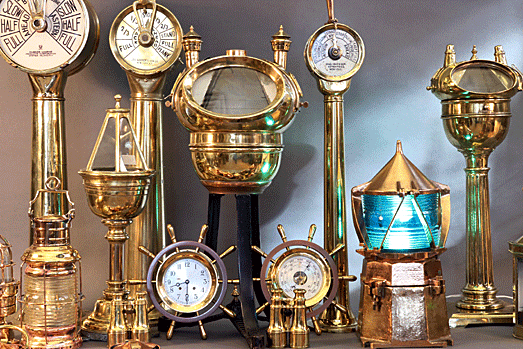
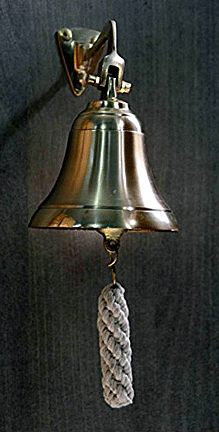 Many
nautical collections start with something passed down in the family,
found in the attic, or picked up for a song. Good items to start with
are mid-19th-century items such as box compasses, ship's lights, old but
not antique sextants, ship's flags, deck watches, chronometers, and
prints. Many
nautical collections start with something passed down in the family,
found in the attic, or picked up for a song. Good items to start with
are mid-19th-century items such as box compasses, ship's lights, old but
not antique sextants, ship's flags, deck watches, chronometers, and
prints.
There were also Walker logs, Waltham, and Hamilton chronometers,
Chadburn's and Ray's & Co. telegraphs, as well as ship's lights by Perko,
and Griffith & Sons. Sextants by C. Plath, Heath, Freiberger, Kelvin &
Wilfred White.
But you need to be careful when collecting nautical antiques. A good
many nautical reproductions, primarily of the astronomical type of
nautical instruments, were made in the Islamic countries in the late
18th and 19th centuries. Unlike other antiques, reproductions don’t have
an adverse effect on the nautical market.
Dating Nautical Instruments
When attempting to date an early nautical instrument, you must consider
the state of communications in the 12th through the 18th centuries. The
word of new inventions and
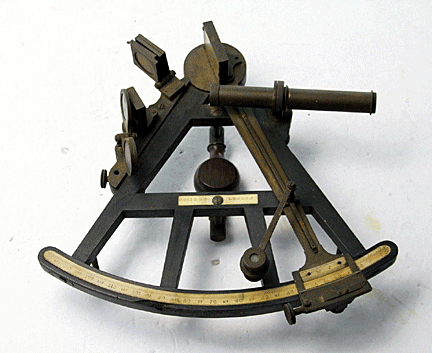 discoveries
was slow to travel. For this reason, it was not uncommon for an
innovation to actually be "reinvented" many times over. Unless an
instrument has its date of manufacture on it, the margin of error in
dating it can be as much as 20 years--more in the case of older
instruments. discoveries
was slow to travel. For this reason, it was not uncommon for an
innovation to actually be "reinvented" many times over. Unless an
instrument has its date of manufacture on it, the margin of error in
dating it can be as much as 20 years--more in the case of older
instruments.
When dating an instrument, you can go by the maker's name on the box or
label, the configuration and construction of the box, the instrument’s
size, type of wood used in its construction verses brass, and evidence
of ivory construction of some components. In the case of sextants and
octants, the presence of backsight, a wooden index arm verses a brass
one, a flat brass index arm verses a braced one, the absence of a
locking screw on
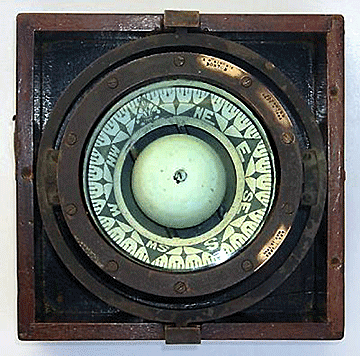 the
index arm, the presence of a vernier scale and the type of scale
division as well as the presence of a scale magnifier affixed to the
index arm. Lastly, the configuration of filters or shades. the
index arm, the presence of a vernier scale and the type of scale
division as well as the presence of a scale magnifier affixed to the
index arm. Lastly, the configuration of filters or shades.
There are many well-known makers of nautical instruments. For instance,
Edward Samuel Ritchie, who invented the liquid compass in 1862. Henry
Gregory of London, famous for his compasses, also made quadrants and
globes from 175001792. Charles Baker made a full range of nautical
instruments from 1851-1858. Carl Plath, of Hamburg, Germany, had a
reputation for manufacturing the finest nautical instruments in the
world at the turn of the century.
The Nautical Antiques Market
The nautical market is stronger today than ever—at least for the rarer,
high-end items, You can still discover fine examples of the Hadley
quadrant at premium prices, but you wouldn’t want to start your
collection there. But later and smaller octants are much more common and
affordable.
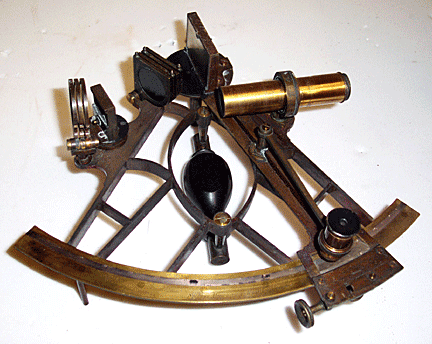 Another
early piece to recently come on the market was a rare hydrographic
surveying sextant known as the 'Quintant'. This large instrument, made
by the London firm of Cary, was designed to take triangulation sightings
when making soundings for Admiralty sea charts. This piece sold for
$4,500. This high price can partly be explained by the overall good
condition of the piece--many antique sextants or octants on the market
are defective or incomplete, reflecting the hard-working heritage of
these invaluable maritime tools. Another
early piece to recently come on the market was a rare hydrographic
surveying sextant known as the 'Quintant'. This large instrument, made
by the London firm of Cary, was designed to take triangulation sightings
when making soundings for Admiralty sea charts. This piece sold for
$4,500. This high price can partly be explained by the overall good
condition of the piece--many antique sextants or octants on the market
are defective or incomplete, reflecting the hard-working heritage of
these invaluable maritime tools.
 If
you’re on a most budget, you can still find interesting and historical
sextants. A typical 19th century octant would probably cost about $900. If
you’re on a most budget, you can still find interesting and historical
sextants. A typical 19th century octant would probably cost about $900.
The market began to broaden with the popularity of the film “Titanic.”
Formerly only the elite, educated and wealthy could collect the very
best nautical antiques.” Today, that has all changed. Fine high-end
nautical items aren’t as plentiful as they used to be, even in seafaring
Maine.
Sailing antiques, in particular, are getting hard to find. If you look
at the “Merchant List” which lists all active ships for a given year
from 1890, you’ll find an amazing number that sank in storms. When a
wooden ship sinks, not much is left, because most of it is wood.
Buying and Selling Nautical Antiques
As a collector of nautical antiques, you must keep up with prices and be
prepared to sell at a moments notice. Sometimes prices of some objects
can actually go down, particularly if the category has gone out of favor
with collectors. Remember that however much fun it is to collect
nautical hardware or uniforms, there may not be many buyers when its
time to sell. It’s also important to consider if you can store and/or
display a particular item before you purchase it. And dealers are often
reluctant to carry bulky items in their inventory.
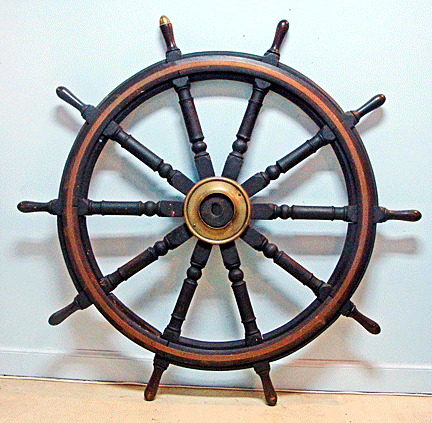 You
should be wary of ship’s wheels as every ship had more than one---some
had several—and these are the items that tended to be saved when the
ship was broken up. So there are lots of them around. How many ships
have existed over time? There are so many in existence that they usually
aren’t worth as much as people think. You
should be wary of ship’s wheels as every ship had more than one---some
had several—and these are the items that tended to be saved when the
ship was broken up. So there are lots of them around. How many ships
have existed over time? There are so many in existence that they usually
aren’t worth as much as people think.
Generally, nautical collectors often don’t want to pay top dollar for
artifacts. They will, however, pay for items that are well documented
and have a known provenance, such as an association with a personality,
a famous ship or event. He says that chronometers, once an item in
demand, are off their high values as are ship’s wheels, lanterns and
binnacles which were all once commanding high values. Now, for example,
good quality original prints of photographs, or albums are desirable, as
are letters, diaries and documents.
 People
are currently paying way too much for the average nautical antique,
based on inflated values being pitched on television and unrealistic
expectations by accumulators and collectors. Television programs about
pickers and pawn shops are building unrealistic expectations of values.
In real life prices paid by serious collectors and dealers will be much
less than portrayed on television. People
are currently paying way too much for the average nautical antique,
based on inflated values being pitched on television and unrealistic
expectations by accumulators and collectors. Television programs about
pickers and pawn shops are building unrealistic expectations of values.
In real life prices paid by serious collectors and dealers will be much
less than portrayed on television.
You should keep a notebook in which to record details of every item you
purchase no matter how small a transaction. That notebook itself will
become a valuable tool later in the life of the collection. Record
details, information about the seller, diagrams, descriptions and any
research you may undertake related to the item. The notebook should be
bound so that you don’t lose bits of paper and everything is kept in
chronological order.
< Back to Collecting Archives
Next Article > |
|

|
|
FOLLOW MY WEEKLY BLOG
Antiques Q&A
JOIN MY COLLECTION
Antiques and More
on Facebook
LIKE MY FACEBOOK PAGE
The Antiques
Almanac on Facebook |
|
No antiques or collectibles
are sold on this site.
|
|
How to Recognize and
Refinish Antiques for Pleasure and Profit
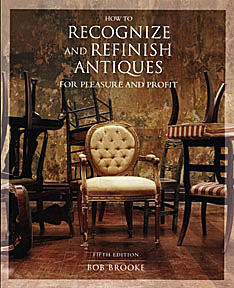
Have
you ever bought an antique or collectible that was less than perfect and
needed some TLC? Bob's new book offers tips and step-by- step
instructions for simple maintenance and restoration of common antiques.
Read an
Excerpt
|
|

|
|
|
|
|
